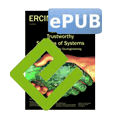 by Werner Steinhögl, Programme Officer at the European Commission, Components and Systems, Directorate General CONNECT
by Werner Steinhögl, Programme Officer at the European Commission, Components and Systems, Directorate General CONNECT
In our modern world, with all aspects of our lives becoming increasingly digitalized, Systems of Systems will play a crucial role. As the embedded world meets the Internet world there will be an increasing number of interacting systems with strong connectivity in both society and in industry. The growing overall complexity of systems has triggered a paradigm shift and the need to enhance the classical view of Systems Engineering towards Systems of Systems (SoS) Engineering. SoS describes the large scale and dynamically varying integration of many independent, self-contained systems to satisfy needs for services that can only be provided by the system as a whole. Examples of SoS include the electrical grid, a large processing plant with many process units, multi-modal traffic control, and combined heat and power generation.
Connectivity between embedded systems and computing devices is predicted to experience massive growth over the coming years. For instance, the consultancy Gartner estimates that by 2020 there will be 26 billion connected devices (excluding PCs, tablets and smartphones) in operation world-wide. This equates to a global market value of $1.9 trillion, of which 80% is expected to come from services. Mastering SoS will be imperative for companies to be successful, because connectivity provides value only if the information is used for improved services, productivity, resource efficiency, and user satisfaction, i.e. if additional functionality is offered and the systems as a whole operate reliably and securely in a SoS.
The field of SoS deals with how to engineer and manage such large interconnected and continuously evolving systems, and is thus fundamental to the realization of this market potential. The EU funded coordination action CPSOS has compiled a state of the art report and identified the challenges for this field. Methods from different domains need to be combined with systems and domain engineering such as control theory for continuous systems, discrete models from computer science for verification/testing and contract-based assertions, structure formation from physics and market mechanisms and evolution of beliefs from economics and social science. Modelling and simulation are crucial in this effort. Promising results have been obtained in some relatively controlled environments, such as chemical plants and traffic management. Yet in general the application of model-based methods in SoS engineering is still at the beginning and needs to find its way from research labs into practice.
Trust in Systems of Systems
Cyber-security is a very important element in Systems of Systems and must be addressed at all system and component levels. A specific SoS challenge is the recognition of obstructive injections of signals or takeovers of components in order to cause malfunctions, suboptimal performance, shutdowns or accidents, e.g. power outages. The detection of such attacks requires taking into account both the behaviour of the physical elements and the computerized monitoring, control and management systems. In the case of the detection of unsecure states, suitable isolation procedures and soft (partial) shut-down strategies must be designed. Needless to say, SoS must also be safe and must comply with relevant safety standards which necessitates a rethinking of certification approaches.
The European Situation
Europe has a strong position in the systems market with an ecosystem of world leading suppliers and systems integrators. The embedded systems industry alone creates 50,000 new jobs every year and Europe accounts for 30% of world production of embedded systems with particular strengths in the automotive sector, aerospace and health. There is fierce competition within the existing €850 billion embedded ICT market with strong players in the US aiming to capitalize on the expanding market. Europe needs to capitalize on its expertise via successful exploitation of ICT in Systems of Systems: there are opportunities to provide efficient, environmentally friendly, autonomous and safe mobility; greater efficiency in management and operations for process automation and smart grids; greater benefits to citizens via smart, safe and secure cities, energy efficient buildings and green infrastructure; and smart devices and services for smart home functionality and assisted living.
However, today’s platforms for systems are often vertically oriented and proprietary which makes it difficult to link heterogeneous subsystems into a SoS. The vision is that a group of autonomously managed subsystems are coordinated and optimized to deliver a joint service. This includes, for instance, seamless and dynamic integration of new incoming subsystems into a SoS even when they come from different suppliers. Hence work on making platforms more open and interoperable is required.
EU support for trustworthy Systems of Systems
The European Union supports collaborative research and innovation in the area of Systems of Systems with an investment of 30 million Euros. In the wider area of Embedded Systems, Cyber-Physical Systems, Security and Internet of Things circa 150 million Euros per year are earmarked in the Horizon 2020 work programme and the Joint Technology Initiative ECSEL. As a flanking measure, the EU supports networks of competence centres to enable access to digital technologies for any industry in Europe.
Acknowledging the importance of digital platforms for industry, the EU and its member states have jointly launched large-scale innovation projects to demonstrate open, integrated and secure technology and operational platforms for product development, process automation and associated services in the ECSEL JTI programme. This will continue, and in addition large scale pilots for Internet of Things platforms are planned. These actions will also contribute to the design, development, demonstration and testing/validation of platforms for SoS and contribute to standardization and stimulation of the related ecosystem and marketplaces.
Links:
CPSOS coordination action: http://www.cpsos.eu
Cyber-Physical Systems in Horizon 2020: https://ec.europa.eu/digital-agenda/en/cyberphysical-systems-0
ECSEL Joint Technology Initiative: http://www.ecsel-ju.eu
Internet of Things in Horizon 2020: https://ec.europa.eu/digital-agenda/en/internet-things










